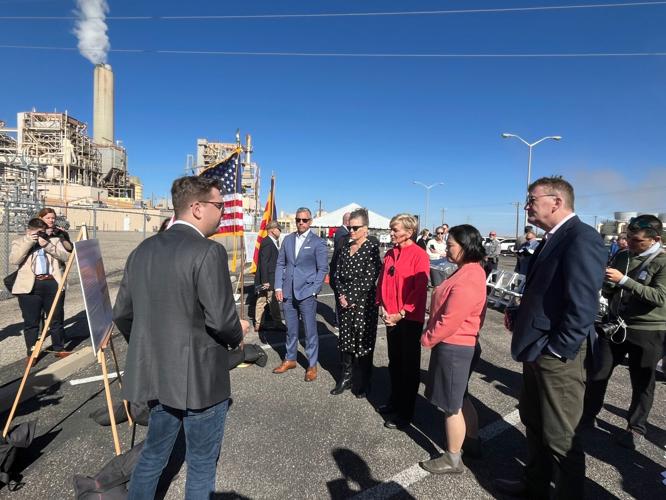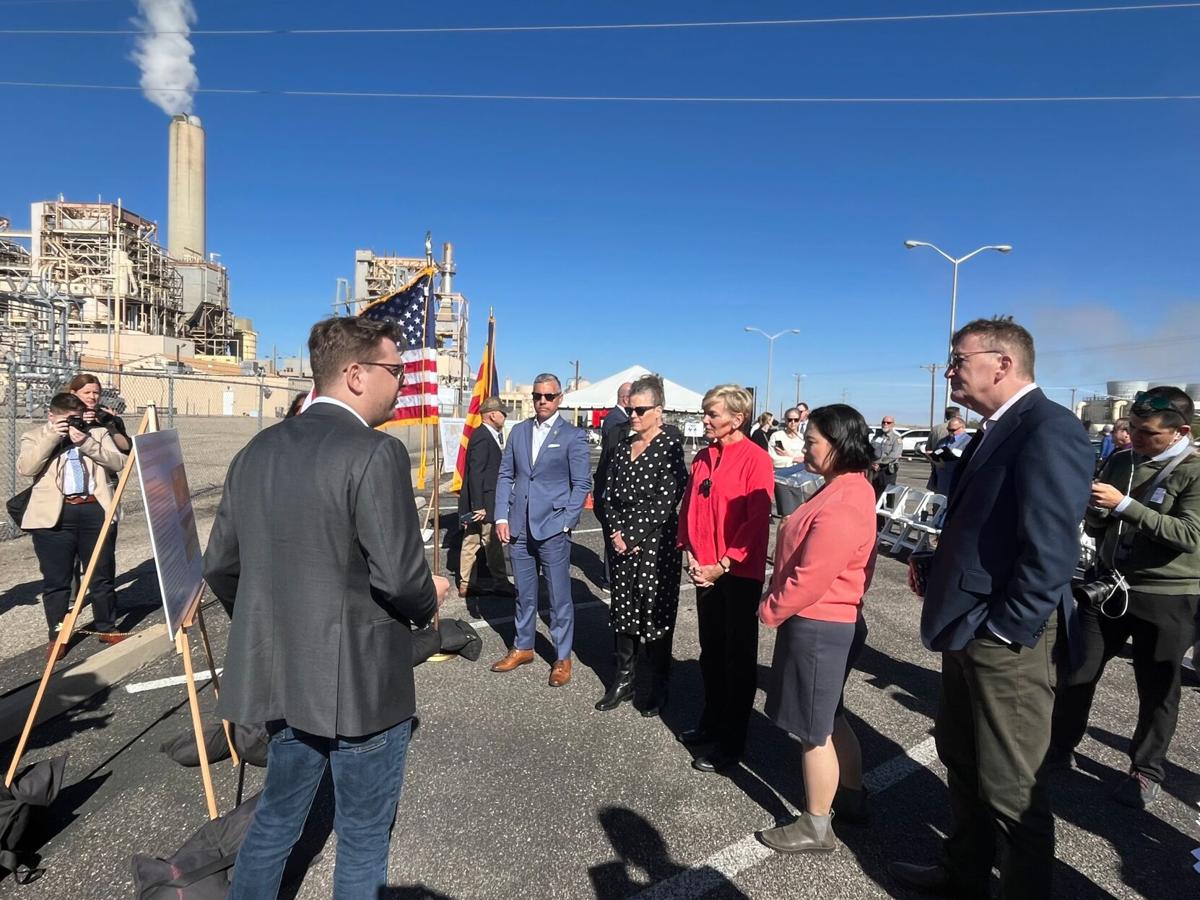A planned high-voltage transmission line linking Tucson and El Paso has won major financial support from the U.S. Department of Energy, promising electric customers in Tucson and across Arizona a key new link to renewable power.
The Southline Transmission Line Project, which includes upgrading an existing transmission line from a Tucson Electric Power substation near Vail to a substation at the Apache Generating Station in northern Cochise County, was one of three projects granted a total of $1.3 billion in financial commitments from the Bipartisan Infrastructure Law’s Transmission Facilitation Program.
The other two projects — announced Monday by U.S. Energy Secretary Jennifer M. Granholm at an event at the Apache Substation — are the 214-mile Cross-Tie 500kV Transmission Line in Nevada and Utah, and the Twin States Clean Energy Link in New Hampshire and Vermont.
Through the program, the DOE will commit $1.3 billion from a $2.5 billion revolving loan fund to purchase a percentage of the total proposed capacity of the eligible transmission lines.
By offering capacity contracts, DOE increases the confidence of additional investors, encourages additional customers to buy transmission-line capacity, and reduces the overall risk for project developers, the Energy Department said.
The project commitments were announced as part of the release of the DOE’s National Transmission Needs Study, an assessment of existing data and current and future transmission needs through 2040.
“We need to build out transmission in every pocket of the country, to improve reliability, obviously, to improve resilience, to lower energy costs,” Granholm said at Monday’s event, also attended by Rep. Juan Ciscomani (R-Arizona), Gov. Katie Hobbs, and other dignitaries.
“Solar and wind in most places are now the cheapest form of energy,” she said, adding that the new study shows a need “to build out this transmission, to relieve congestion, because there are areas that are just blocked because there’s no capacity to be bringing on new power.”
“The Southline Transmission Project will be transformative in accessing clean and reliable energy in our region,” said Ciscomani, who had urged the DOE in a letter to back the project.

A map of the planned Southline Transmission Project
Besides the upgraded Arizona segment, the 278-mile Southline project includes a new high-voltage transmission line that will run from Afton, New Mexico, about 30 miles northwest of El Paso, west to Hidalgo in eastern New Mexico, and then through eastern Arizona to an interconnection to the upgraded line at the Apache power plant.
Southline could be operational by the end of 2027, its founding partners said.
Linking to TEP
Southline is being co-developed by the investment firm Black Forest Partners and a subsidiary of Houston-based transmission line developer Grid United LLC, with founding investor Hunt Transmission Services.
The project won environmental approval from the U.S. Bureau of Land Management in 2016 and the go-ahead from the Arizona Corporation Commission in 2017.
The developers say the new and upgraded line will transport power bi-directionally and enable wind and solar resources from the desert Southwest to reach key markets while improving the grid reliability of the border region.
TEP is not directly involved in developing the Southline project, but in 2021, TEP acquired rights from Southline to upgrade a 64-mile western segment from its Vail Substation south of Tucson to its Tortolita substation northwest of the city, under a co-location agreement with the Western Area Power Administration.
TEP spokesman Joe Barrios said that even though its Vail-to-Tortolita line with WAPA is not part of the Southline project, it is expected to benefit TEP and its customers at it interconnects with the local grid.
“Southline would add transmission capacity in the Southwest, which would be favorable because our regional energy grid faces considerable capacity constraints,” Barrios said, noting that TEP buys power to satisfy peak energy demand, especially in the summer.
Southline could also provide TEP with additional options for importing energy to serve its customers, including energy generated by its own resources in New Mexico, including the Oso Grande and Macho Springs wind farms and the Luna Generating Station, he said.
“We are interested to learn how the line could provide additional options for purchasing power from new wind and solar resources in the Southwest,” Barrios added.
TEP is currently working to upgrade a 115-kilovolt WAPA line with a double-circuit, 230-kV transmission line, with each owning and operating one circuit upon completion.
SunZia breaks ground
Meanwhile, another major transmission line between Arizona and New Mexico, the SunZia Southwest Transmission Project, is proceeding despite vehement opposition from native American tribes and environmentalists in the Lower San Pedro Valley.
The 550-mile SunZia line will tap into power from a massive wind farm in New Mexico and deliver it to Arizona and the Western grid.
That project, which will serve the planned 3.5-gigawatt SunZia Wind Project in central New Mexico, won final federal approvals in May and broke ground in September, though an environmentalist has filed an appeal of a state court ruling upholding the project’s approval by the Arizona Corporation Commission.
But the Tohono O’odham Nation, the San Carlos Apache Tribe and Tucson-based Archaeology Southwest have formally disputed the Bureau of Land Management’s approval of SunZia, citing the line’s potential impact on culturally important sites in the San Pedro Valley.
And last week, the Tohono O’odham’s chairman called on Interior Secretary Deb Haaland to halt construction.






